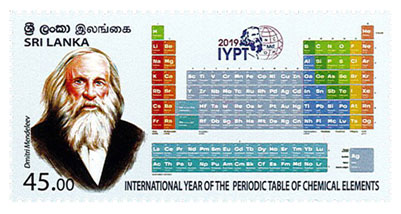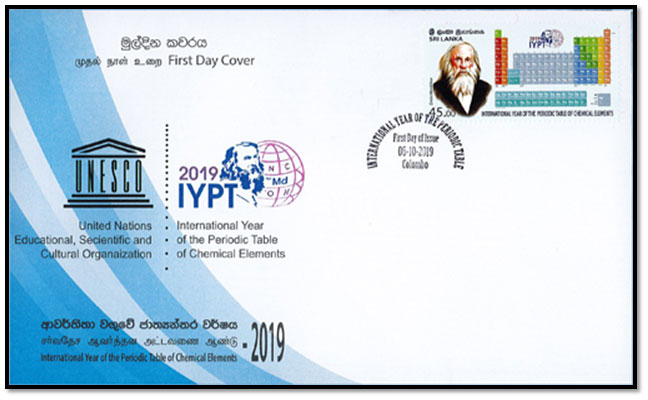

Home/Active Page

The philatelic bureau of the Postal Department has issued a stamp, worth Rs. 45.00 on October 06, 2019 to mark the International Year of the Periodic Table.
| Date of Issue | 06th of October 2019 |
| Denomination | Rs.45.00 |
| Catalogue No: | CSL 2342 |
| Stamp Designer | P.Isuru Chathuranga | Stamp Size: | 60mm x 30mm |
| Sheet Composition: | 20 stamps per sheet |

The philatelic bureau of the Postal Department has Issued a stamp, worth Rs. 45.00 on October 06, 2019 to mark the International Year of the Periodic Table.
The Periodic Table of Chemical Elements is recognized as one of the most important achievements in science. It not only captures the essence of chemistry, but it also captures the essence of physics, medicine, earth sciences and biology.
Russian chemistry professor, Dmitri Mendeleev came up with the Periodic System in 1869. 2019 will be the 150th anniversary of the discovery of the Periodic Table of Chemical Elements and United Nations General Assembly and UNESCO have therefore proclaimed 2019 as the "International Year of the Periodic Table of Chemical Elements (IYPT2019)".
Mendeleev constructed his Periodic table by listing the elements in rows or columns in order of atomic weight and starting a new row or column when the characteristics of the elements began to repeat. An atom comprises of protons, neutrons and electrons. Protons. Every atom is composed of a nucleus and one or more electrons bound to the nucleus. More than 99.94% of an atom's mass is in the nucleus.
Mendeleev left gaps in the table when it seemed that the corresponding element had not yet been discovered. By the late 19th century not all elements had been discovered. Mendeleev was also the first to be recognized as using the trends in his periodic table to predict the properties of those missing elements, such as gallium and germanium.
The scientists which followed Mendeleev expanded the Periodic table by filling in the gaps in the table. Phosphorus was the first particle that was discovered although humans had been using metals like silver and gold for years. This was done in 1669 Hennig Brand and 1680 Robert Boyle. By 1809 at least 47 elements were discovered. By 1869 the number of identified elements had risen to 63.
Scientists began to see patterns in the characteristics and they starred grouping these elements based in their characteristics. John Newlands and Alexandre-Émile Béguyer de Chancourtois too published early forms of the periodic table. However they were not clear. Dmitri Mendelee figured out a way to address the concerns in the early periodic tables. In 1894 Sir William Ramsay and Lord Rayleigh discovered the noble gases, which were added to the periodic table as group 0. In 1914 English physicist Henry Moseley provided atomic numbers, based on the number of electrons in an atom, rather than based on atomic mass. In 1945 Glenn Seaborg identified lanthanides and actinides (atomic number >92), which are usually placed below the periodic table. A number of components were found by the Manhattan Project that produced the first nuclear weapons.
A group or family is a vertical column in the periodic table. Groups usually have more significant periodic trends than periods and blocks. Elements in the same group tend to have a shared chemistry and exhibit a clear trend in properties with increasing atomic number. The seven rows of the table, called periods, generally have metals on the left and non-metals on the right. The columns, called groups, contain elements with similar chemical behaviours. Six groups have accepted names as well as assigned numbers: for example, group 17 elements are the halogens; and group 18 are the noble gases. Also displayed are four simple rectangular areas or blocks associated with the filling of different atomic orbitals.
The elements from atomic numbers 1 (hydrogen) through 118 (oganesson) have been discovered or synthesized, completing seven full rows of the periodic table. The first 94 elements all occur naturally, though some are found only in trace amounts and a few were discovered in nature only after having first been synthesized. Elements 95 to 118 have only been synthesized in laboratories or nuclear reactors.
All rights received. All right to identify the Department of Posts as the Author and designer of this Bulleting has been asserted in accordance with the Copyright, Design and Patents Act 1988.No part to this publication may be reproduced, stored in or introduced into a retrieval system, or transmitted in any form or by and means (electronic, mechanical, photocopying, recording or otherwise) without the prior permission from the publisher. Any person who does and unauthorized act in relation to this publication may be liable to criminal prosecution and civil claims for damages.